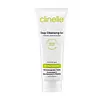What's inside
What's inside
 Key Ingredients
Key Ingredients

 Benefits
Benefits

 Concerns
Concerns

 Ingredients Side-by-side
Ingredients Side-by-side

Water
Skin ConditioningDecyl Glucoside
CleansingAcrylates Copolymer
Cocamidopropyl Betaine
CleansingPPG-26-Buteth-26
Skin ConditioningPEG-40 Hydrogenated Castor Oil
EmulsifyingPhenoxyethanol
PreservativePEG-90 Glyceryl Isostearate
CleansingCoco-Glucoside
CleansingGlyceryl Oleate
EmollientChlorphenesin
AntimicrobialSodium Hydroxide
BufferingCitric Acid
BufferingLaureth-2
CleansingBisabolol
MaskingCitrus Limon Peel Oil
MaskingLavandula Hybrida Oil
EmollientO-Cymen-5-Ol
AntimicrobialTocopheryl Acetate
AntioxidantPropylene Glycol
HumectantMenthyl Lactate
MaskingArnica Montana Flower Extract
MaskingHelianthus Annuus Seed Oil
EmollientAloe Barbadensis Leaf Juice
Skin ConditioningTocopherol
AntioxidantHydrogenated Palm Glycerides Citrate
EmollientLecithin
EmollientPanax Ginseng Root Extract
EmollientHedera Helix Extract
AntimicrobialAscorbyl Palmitate
AntioxidantAsiaticoside
AntioxidantAsiatic Acid
Skin ConditioningMadecassic Acid
Skin ConditioningCamellia Sinensis Leaf Extract
AntimicrobialPotassium Sorbate
PreservativeSodium Benzoate
MaskingWater, Decyl Glucoside, Acrylates Copolymer, Cocamidopropyl Betaine, PPG-26-Buteth-26, PEG-40 Hydrogenated Castor Oil, Phenoxyethanol, PEG-90 Glyceryl Isostearate, Coco-Glucoside, Glyceryl Oleate, Chlorphenesin, Sodium Hydroxide, Citric Acid, Laureth-2, Bisabolol, Citrus Limon Peel Oil, Lavandula Hybrida Oil, O-Cymen-5-Ol, Tocopheryl Acetate, Propylene Glycol, Menthyl Lactate, Arnica Montana Flower Extract, Helianthus Annuus Seed Oil, Aloe Barbadensis Leaf Juice, Tocopherol, Hydrogenated Palm Glycerides Citrate, Lecithin, Panax Ginseng Root Extract, Hedera Helix Extract, Ascorbyl Palmitate, Asiaticoside, Asiatic Acid, Madecassic Acid, Camellia Sinensis Leaf Extract, Potassium Sorbate, Sodium Benzoate
Water
Skin ConditioningMyristic Acid
CleansingGlycerin
HumectantPotassium Hydroxide
BufferingCoco-Glucoside
CleansingStearic Acid
CleansingPalmitic Acid
EmollientGlycol Distearate
EmollientCocamidopropyl Betaine
CleansingGlyceryl Stearate
EmollientBeeswax
Emulsion StabilisingSorbitan Olivate
EmulsifyingPEG-100 Stearate
Phenoxyethanol
PreservativeSodium Chloride
MaskingHydroxyethylcellulose
Emulsion StabilisingEthylhexylglycerin
Skin ConditioningAllantoin
Skin ConditioningPanthenol
Skin ConditioningMelaleuca Alternifolia Leaf Oil
AntioxidantDisodium EDTA
Paeonia Lactiflora Root Extract
Skin ConditioningGlycyrrhiza Glabra Root Extract
BleachingPolygonum Multiflorum Root Extract
Skin ConditioningPhellinus Linteus Extract
Skin ConditioningMorus Alba Bark Extract
Skin ConditioningSophora Flavescens Root Extract
AntioxidantCimicifuga Racemosa Root Extract
AntimicrobialSesamum Indicum Seed Extract
Skin ConditioningAngelica Gigas Root Extract
Skin ConditioningScutellaria Baicalensis Root Extract
AstringentBetaine
HumectantSalicylic Acid
Masking1,2-Hexanediol
Skin ConditioningSodium Hyaluronate
HumectantWater, Myristic Acid, Glycerin, Potassium Hydroxide, Coco-Glucoside, Stearic Acid, Palmitic Acid, Glycol Distearate, Cocamidopropyl Betaine, Glyceryl Stearate, Beeswax, Sorbitan Olivate, PEG-100 Stearate, Phenoxyethanol, Sodium Chloride, Hydroxyethylcellulose, Ethylhexylglycerin, Allantoin, Panthenol, Melaleuca Alternifolia Leaf Oil, Disodium EDTA, Paeonia Lactiflora Root Extract, Glycyrrhiza Glabra Root Extract, Polygonum Multiflorum Root Extract, Phellinus Linteus Extract, Morus Alba Bark Extract, Sophora Flavescens Root Extract, Cimicifuga Racemosa Root Extract, Sesamum Indicum Seed Extract, Angelica Gigas Root Extract, Scutellaria Baicalensis Root Extract, Betaine, Salicylic Acid, 1,2-Hexanediol, Sodium Hyaluronate
Ingredients Explained
These ingredients are found in both products.
Ingredients higher up in an ingredient list are typically present in a larger amount.
Cocamidopropyl Betaine is a fatty acid created by mixing similar compounds in coconut oil and dimethylaminopropylamine, a compound with two amino groups.
This ingredient is a surfactant and cleanser. It helps gather the dirt, pollutants, and other impurities in your skin to be washed away. It also helps thicken a product and make the texture more creamy.
Being created from coconut oil means Cocamidopropyl Betaine is hydrating for the skin.
While Cocamidopropyl Betaine was believed to be an allergen, a study from 2012 disproved this. It found two compounds in unpure Cocamidopropyl Betaine to be the irritants: aminoamide and 3-dimethylaminopropylamine. High-grade and pure Cocamidopropyl Betaine did not induce allergic reactions during this study.
Learn more about Cocamidopropyl BetaineCoco-Glucoside is a surfactant, or a cleansing ingredient. It is made from glucose and coconut oil.
Surfactants help gather dirt, oil, and other pollutants from your skin to be rinsed away.
This ingredient is considered gentle and non-comedogenic. However, it may still be irritating for some.
Learn more about Coco-GlucosidePhenoxyethanol is a preservative that has germicide, antimicrobial, and aromatic properties. Studies show that phenoxyethanol can prevent microbial growth. By itself, it has a scent that is similar to that of a rose.
It's often used in formulations along with Caprylyl Glycol to preserve the shelf life of products.
Water. It's the most common cosmetic ingredient of all. You'll usually see it at the top of ingredient lists, meaning that it makes up the largest part of the product.
So why is it so popular? Water most often acts as a solvent - this means that it helps dissolve other ingredients into the formulation.
You'll also recognize water as that liquid we all need to stay alive. If you see this, drink a glass of water. Stay hydrated!
Learn more about Water